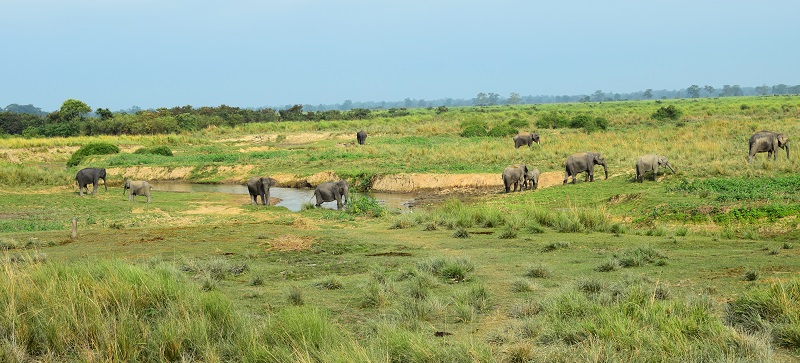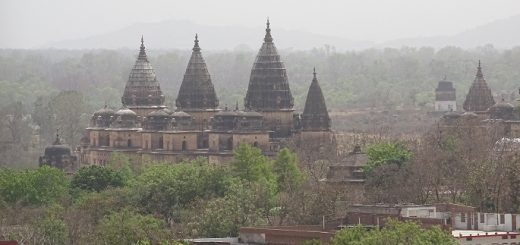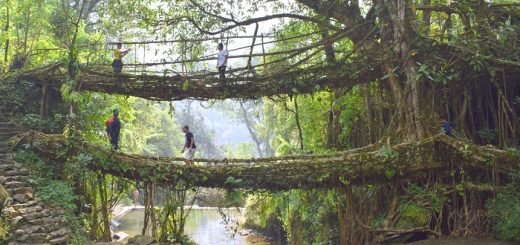A Bike Ride To Kaziranga National Park In Assam: Ride From Guwahati To Kohora
Back in school days, I used to participate in a lot of general knowledge competitions. I represented my school in many events and won prizes. While preparing for those competitions, I used to read different topics, and National Parks and Wildlife Sanctuaries in India was one such topic. During those days, I first learned about the Kaziranga National Park and where it lies, and today I was riding from Guwahati to Kaziranga. The Kaziranga National Park is the second-largest national park in Assam after Manas National Park, covering an area of 430 sq kilometers. It is a UNESCO World Heritage Site and has the highest tiger density in the world. Yet the main attraction of the national park is “One-Horned Rhinoceros” or “The Great Indian Rhinoceros.” The national park is home to nearly 2400 rhinoceros, and there has been a steady increase in their count. Since the park spreads in a vast area, it requires proper planning else it would be a waste of money and time. Today was my third day in Assam and tenth day in North-East India, and I planned to ride from Guwahati to Kaziranga. The Kaziranga National Park is one of the major tourist attractions in North East India and a must-visit place for first-time visitors in the north-east. Before visiting the national park, I had already done my homework and gathered much information while I was staying in Guwahati. I spent two days in Kaziranga National Park and explored the national park thoroughly. After completing my trip, I thought of sharing my ride as I have been doing in the past. Therefore in this article, I will be sharing my Bike Ride to Kaziranga National Park, the route and road conditions as well as how I explored the Kaziranga National Park. In the future article, I will be sharing a detailed travel guide to explore the Kaziranga National park, which would help anyone visiting in the future. I hope my article would be helpful as my previous posts, and travelers can explore this national park in the best possible way.
Also Read: A Detailed Travel Guide To Explore Kaziranga National Park
Qucik Navigate:
Switched My Vehicle From Royle Enfield To Honda Activa
Also Read: A Travel Guide To The Gateway Of Northeast India
As mentioned earlier, it was my 10th-day ride, and I planned to cover entire North-East India on a motorcycle. During my trip to Meghalaya, I rode Royal Enfiled, but once I reached Guwahati, I decided to change the bike. There were two reasons for this, one I faced an issue with the motorcycle while returning from the Krang Shuri Waterfall and again while exploring the Guwahati city. The second reason was the budget constraints, as I had to pay 1000 rupees daily, and a long ride via bullet was a significant burden on my pocket. Therefore I decided to switch to a smaller vehicle and asked the bike rental guy to provide me a scooter. Initially, he was hesitant as the North-East terrain is very rugged, but upon my insisting, he agreed to rent me a scooter. Now my new companion was Honda Activa 110Cc, and its charges were 300 rupees per day, which looked like a good deal. Now, I can travel for a month on the same budget that would have lasted only for seven days if I had ridden a motorcycle. The only thing I had to take into consideration was the small fuel tank of the scooter as it can only hold 6 liters of petrol. To overcome this, I decided to carry an extra 2 liters of petrol in a bottle for any worst-case scenario. The scooter has a disadvantage that I can’t ride fast, but it was okay for me as I was in the northeast for traveling, not for a racing event.
Honda Activa Ride From Guwahati To Kaziranga National Park
I woke up early in the morning as the Kaziranga National Park is 220 kilometers from Guwahati, and a dealy would mean wasting precious time in the city’s traffic. By 6:30 AM, I completed the checkout formalities, tied my bag on scooty, and started riding for the Kaziranga. Once I reached Jorabat, I took a 15 minutes tea break, as riding an empty stomach is not a good idea. Moreover, it was my first 200 plus kilometer ride in the region, and I was not sure if I will get restaurants en route. After a light breakfast, I started again. At Jorabat, there is a T-Point from where one road goes to Shillong while another goes to Kaziranga and connects Jorhat, Dibrugarh, and Tinsukia to capital city Guwahati. The ride was smooth, and I hardly saw any traffic on the highway. It was morning time, and I was maintaining a speed of 60-70 KMPH, yet I felt the cold. The National Highway 27 connects Guwahati to Nagaon, and from Nagaon, the State Highway (SH1 orAH1) goes towards Kaziranga National Park. The highway has rice filed and thick forest cover on both sides, but it was the less traffic made that made the whole ride memorable.
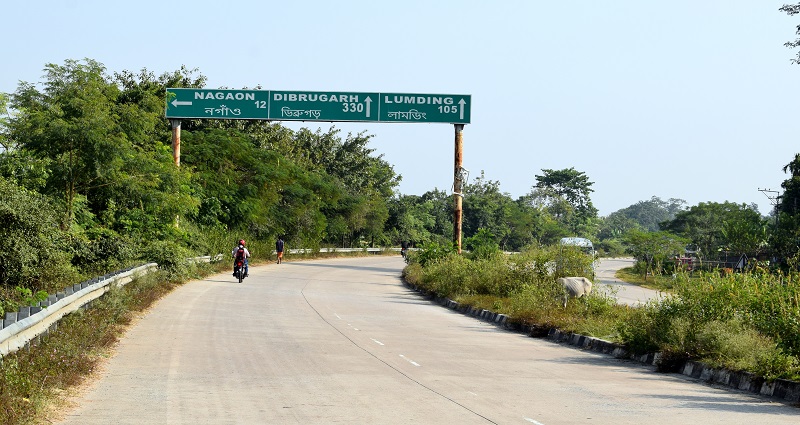
If you type Kaziranga National Park in google maps, it will show the entrance gate of the national park, which is 170 kilometers from Guwahati. In reality, you have to enter Kohora (220KM), which is the central range of the national park, and tickets and accommodation are available at Kohora. The route to Kaziranga National Park is as follow : Guwahati-> Jorabat-> Jagiroad-> Roha-> Jagaon (By-Pass)-> Kaliabor-> Kohara. At Jagaon and there are two roundabouts; from there, I took the state highway and continued my journey towards Kohora. By the time I reached Kaliabor, it was 11:30 AM, and I decided to take a lunch break. From Kaliabor, the highway is more mesmerizing as The Kaziranga Animal Corridor starts. The Kaziranga Animal Corridor is a road that passes through the Kaziranga National Park. The road is more than 50 kilometers long, and drivers are requested to maintain speed in this corridor, avoiding an accident with wild animals. I was in no hurry and took multiple breaks to click photos. Throughout the corridor, the state tourism department and the forest department have erected hoarding describing facts and information about the Kaziranga National Park. Information like the establishment of Kaziranga National Park, the area it covers, the population of species living it, and many more. It looked like a virtual tour of the national park even before entering.
By afternoon, I reached the gate of the Western Zone of Kaziranga, also called the Bagori Range, and from here, Kohora is only 13 kilometers. I noticed small houses on the side of the road, and they were selling handicrafts related to Kaziranga and its animals. I always thought about how nature provides a livelihood to so many people, be it the Ganges in Uttrakhand or Rhinos here in Kaziranga. Directly and indirectly, the Kaziranga National Park acts as the only source of income for thousands of people living in this area. By the time I arrived at Kohora, hotels, restaurants, and homestays started appearing. Upon reaching Kohora, I quickly searched for a homestay and found one within 5 minutes. The homestay was excellent, and they had a dormitory with 100 rupees per bed. Since I was more into traveling than staying into fancy hotels, I booked one bed in the dormitory, kept my luggage near the reception, and went straight to the Safari counter at Kohora.
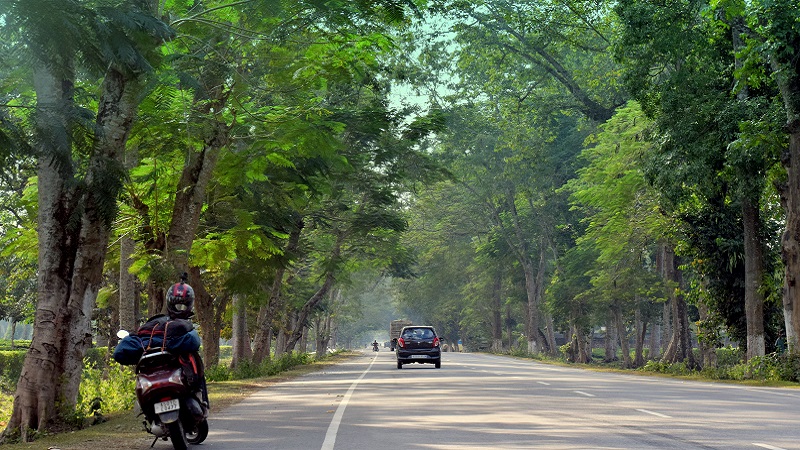
Booking Safari At Kaziranga National Park And Exploring Kohora
The Safari at Kaziranga allows six-person in one safari, and as I was traveling solo, so I had to arrange a few people to share the cost. I checked at the booking counter if anyone is also waiting to be part of a group to share the cost. The person at the desk pointed me to three guys sitting on a bench, waiting for one more to join them. I inquired if I could join them as I am traveling solo, to which they said they are more than happy to split the fare. As we were four members now, we decided to utilize the waiting time in booking the tickets and getting other permits as we have one foreigner in our team. We went to the ticket counter and booked one safari and later split the fare. Once we finalized the booking, we had to wait for more than an hour as afternoon safari begins around 3 PM. I decided to explore the local market, started my scooty, and reached the main market. Although the Kaziranga National Park is a famous tourist destination in Assam, the market was a simpler one. The shops selling gifts and souvenirs were small, barring a few, and even the eateries were small like village markets in India. At Kohora, one road goes towards the entrance gate of Central Range, and they’re also the market looked similar to one I found on the highway. I stopped at one small shop for tea, and by the time I finished my drink, I got a call that Safari Driver has arrived, and they would be leaving in 10 minutes. I quickly went to the homestay, parked my bike, and asked them to pick me up from the highway.
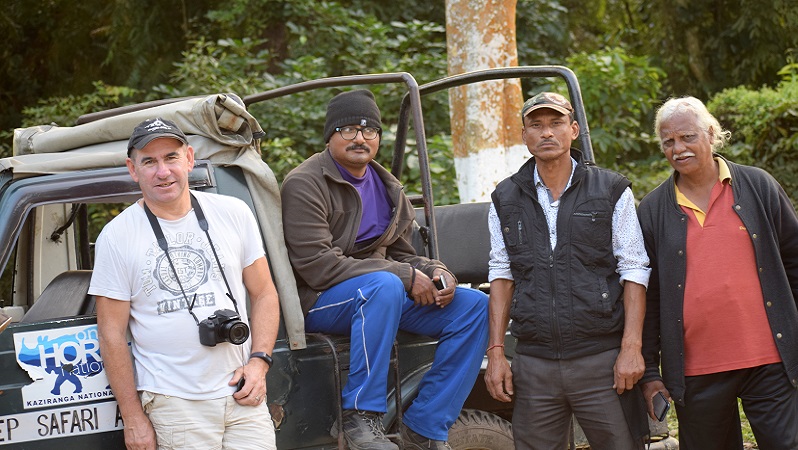
Safari Ride to The Bagori Range or Western Range of Kaziranga
Before narrating my safari ride at the Bagori range, it is necessary to introduce my partners. I shared the safari with three other guys, and they were Lalam, Ram (both from Kerala), and Charles (from France). While Lalam and Ram were in Assam for some social service-related events, Charles was traveling solo. He reached Guwahati a couple of days back and today planned to do a safari ride. He described himself as the bird lover and on a mission to see a tiger and capture photos. While Charles and I were carrying our camera, Lalam and Ram were dependent on their mobile phones for any picture. Our driver drove from Kohora to Bagori, and in ten minutes, we were at the check-post of the Western Range. Once verification completed, the Forrest officials assigned a guard, and we were officially inside Kaziranga. The jeep safari in Kaziranga lasts for two to three hours, and they have a fixed route on which they rode their vehicle. I saw many more jeeps behind us, and I was skeptical if I would be able to see any Rihnos or not. It would have been hardly 5 minutes, and I saw a glimpse of my first Rhino, standing in the swamp and eating. For me, it was time to change the lens, and I witched to 70-300 mm lens to get a close look. The Rhino looked so adorable, minding with his own business unaware of the fact that so many cameras are pointing towards it. I was not aware of what precisely the Rhino eats, but it looked like he was serious about the task he was doing.
After the first encounter with Rhino, I saw many more during my safari ride. Not only the Rhinos, but I also saw Water Buffalos and Elephants, which are other major attractions of the park. While everyone was enjoying the ride, I noticed Charles being the biggest beneficiary, and whenever he saw the animal, he used to inform us. The safari driver looked experienced and stopped the vehicle whenever we asked to stop. Moreover, he pointed out animals which we might have missed and explained their name and other relevant information. After a bumpy 2.5 hours visit to the western range, it was time for return. While returning, we saw a calf with his mother resting under a thick bush and thanked our driver for pointing out. Once the ride was over, the driver dropped us near the entrance gate of the Kohora Range. Time was six in the evening, and by this time, we all started feeling cold. We decided to go for a tea break and discussed everyone’s plan. I wished Charles a bit of good luck in finding Tiger and asked to share the image of he sees one. After finishing our tea, we all went to our respective hotels, and I asked my homestay owner to book an elephant ride for me for tomorrow morning. I went to a nearby restaurant for dinner, and as there was nothing more for me to do in the market, I came back and slept early.
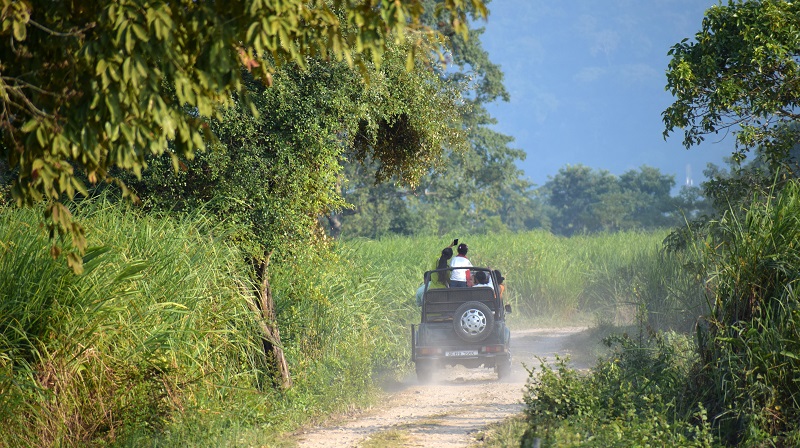
Elephant Ride At Kaziranga National Park
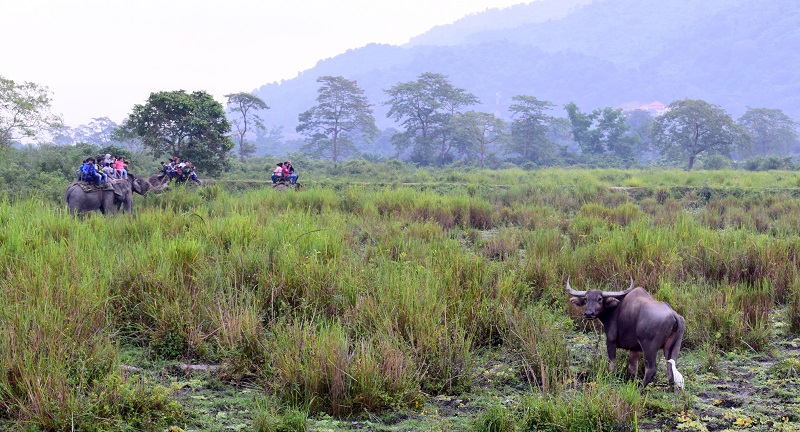
The elephant ride in Kaziranga starts early in the morning, and I reached the gates of the Bagori Range by 5 AM. It was chilling, and I felt the temperature around 10-15 degrees. To me, the ride from Kohora to Bagori was a mammoth task with my hands freezing. Upon reaching the Bagori range, I showed my ticket and parked my scooter at the parking lot. After waiting for 30 minutes, my turn came up, and I sat on one elephant. Initially, I was a bit uncomfortable and struggled to click photos on a moving elephant but later adjusted myself. The advantage of exploring the park on an elephant is that it allows seeing the Rhinos and other animals from a closer distance. While the jeep can’t move on swamps and mud and scares away the animal, it was an easy task for the elephant. I was able to get a closer shot and took at least hundreds of photos. The elephant ride went on for around two hours, and they covered a considerable portion of the park. Once the trip was over, I gave bananas to the elephant, picked up my scooter, and rode back to my room.
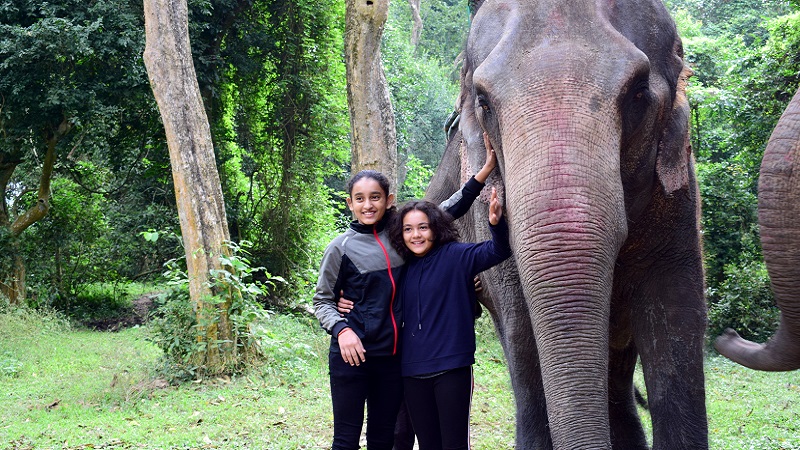
Exploring the Central Range or Kohora Range of Kaziranga National Park
Now I had toured the western range on both safari and elephant; now, my turn was to do the same for the Central Range, i.e., Kohora. My homestay owner informed me that the central range is reserved for foreigners which seemed odd to me as to why can’t I visit the central range. I went to the information center at Kohora and inquired the same. The official said that there is nothing like reserved for foreigners; it is just that the foreigners are recommended to visit the central range. Foreigners get preference over India citizens in terms of central range. When I asked if I could book a jeep/elephant ride for the central range to which he replied that if there is any vacant seat, I might get a chance. I gave my phone number and requested the officer to inform me if there is a vacancy. In the afternoon, I got a call that there is a seat available in the elephant safari, and I immediately purchased the ticket. Now it was my turn to explore the Central Range on an elephant after doing the same in western range.
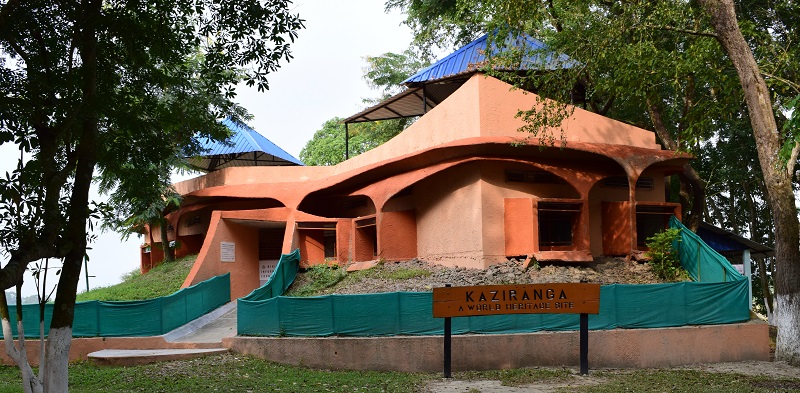
The Central Range of Kaziranga National Park has fewer trees allowing to spot animals from a long distance. I saw a herd of elephant drinking at a nearby pool and spotted many more Rhinos. Though the Kaziranga National park has the largest concentration of tigers, I didn’t saw one after three rides to the park. I ended my day with an elephant ride, and I was in a dilemma whether I should go for Jeep safari again or not. The jeep safari would cost me an additional 1000 rupees, and I had already spent 3000 rupees in two days on safari and elephant ride. There is one more zone in Kaziranga National Park called the Eastern Range or the Agoratoli Range, but I decided to visit it during the last leg of my ride while returning from Jorhat. Eventually, I dropped my plan of jeep safari to Central Range and decided to ride for Haflong via Lumding.
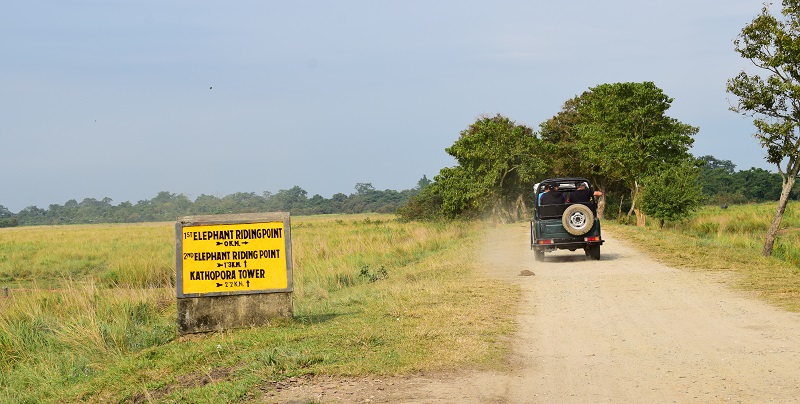
At night, I went to a nearby restaurant and met a Sikh truck driver and enquired about the route and road condition towards Silchar. He informed me that the rode is a mix of good and bad patches and cautioned me not to venture towards Haflong. He said there is nothing to see in Haflong, and it is better to visit Arunachal or Meghalaya. I informed him that I have already covered Meghalaya and planned to do Arunanchal later. Once I explained my detailed plan, he got some confidence in me and realized that I am not bluffing, but indeed planning to ride to Silchar vis Haflong. He suggested to me the route I should take and other precautions while riding in the southern Assam. Following a good discussion and a nice dinner, I returned to my room and packed my luggage for tomorrow’s ride. It was a wonderful two days I spent at Kaziranga National Park capturing hundreds of images in my camera, and uncountable memories in memory. With the longest ride on the next day, I went for sleep, hoping to reach early tomorrow. Later in my journey, I also visited the Manas National Park in Assam and explored the sanctuary. I will be sharing my experience later in my future travelogues.
